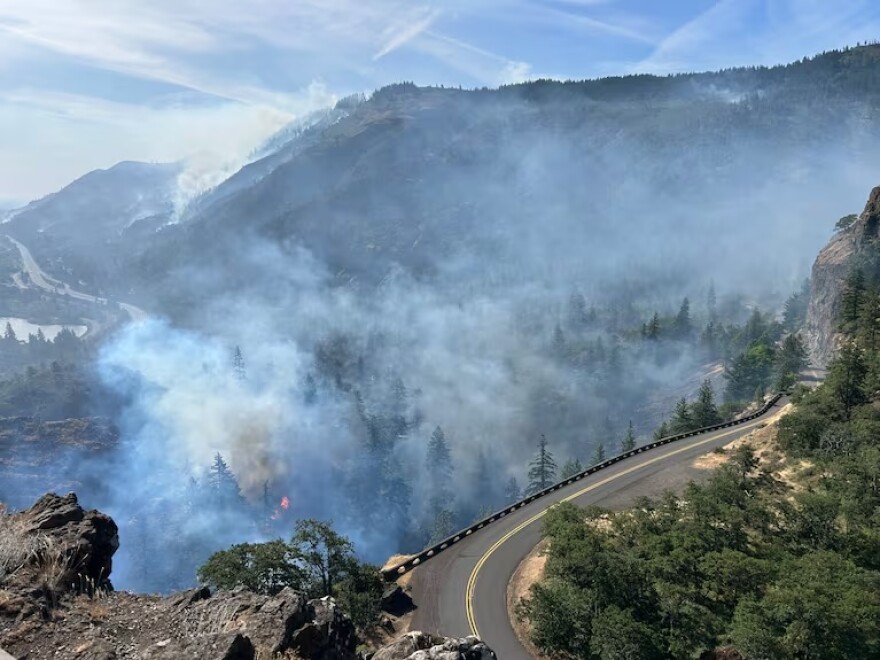Oregon lawmakers will return to Salem next month to try and find a solution to stave off mass layoffs and station closures at the state transportation department.
The stakes are particularly high. Wildfire season is underway across the state. If the legislature fails to act, state and county officials fear the fallout could leave vast stretches of highway with even fewer transportation staff and facilities that help prop up Oregon’s emergency response network.
“They are the backup to our frontline firefighters and cops,” said Melissa Unger, executive director of SEIU Local 503, the union that represents roughly 2,500 Oregon Department of Transportation operations and maintenance workers.
ODOT had planned to lay off nearly 500 workers and close 12 maintenance stations due to a massive budget gap that lawmakers failed to address in the regular 2025 legislative session. County road departments, which manage many of Oregon’s roads and bridges, are also facing financial problems and potential layoffs.
Last week, Gov. Tina Kotek announced an Aug. 29 special session and ordered ODOT to delay its plans. The governor said she expects lawmakers to reach a deal.
“If we lose all these staff, we’re going to lose a huge body of expertise that we might not ever be able to get back,” ODOT spokesperson Kacey Davey said.
Emergency response
Transportation officials play a critical role in keeping Oregonians safe from natural hazards like floods, blizzards and fires. Situated in many of the state’s far-flung corners, ODOT workers are often among the first people available for miles when a fire breaks out.
Staff close off roads and direct drivers where it is safe to travel, often through road signs, helping move residents through detours and evacuations. They also help repair damaged roads and bridges which can prevent water trucks from quickly accessing a fire.
In many rural communities, transportation agencies are the only institutions with large equipment that can help clear debris, such as landslides and downed trees, off roads for firefighters and for the public when a road reopens. Using bulldozers, they sometimes help set up firebreaks to slow the spread of wildfire.
“We stay with it until the very end, around the clock,” said Rolon Williams, a transportation maintenance manager for ODOT who works in Central Oregon. “(ODOT workers) have to be a jack of all trades.”

Wildfires spark across state
Oregon’s wildfire season has ramped up over the past month.
A fire in Central Oregon reached more than 95,000 acres, the nation’s largest at the time, but firefighters have made progress containing it. A state dashboard on Friday listed 35 active fires statewide that have collectively burned more than 108,000 acres.
Many state transportation staffers have been dispatched to help.
Dozens of ODOT staff responded to the Rowena fire in June in an unincorporated area outside The Dalles. The fire closed Interstate 84 for 12 hours due to fallen power lines and trees as firefighters responded to the area. Meanwhile, ODOT also staffed road closures along Highway 30. A section of the highway remains closed.
“Repairs need to be done to the guardrail and hazard trees need to be removed before we can fully open, but this work is on hold due to funding challenges,” Davey said.

Cuts loom over rural Oregon
Such large fires have become increasingly common in the West, especially for residents in rural Oregon. Life in the small communities that dot the state’s countryside is heavily interconnected with the state’s forests, fields and other natural landscapes. Often, there are few roads and bridges that connect these communities.
This sparse connection could leave rural Oregon vulnerable beyond fire season. Unmanaged culverts can cause floodwaters to cover roads. Unplowed highways could keep students from attending school and residents from going about their daily drives.
“This winter will be potentially catastrophic,” said Brian Worley, the county road program manager for the Association of Oregon Counties.
These incidents can isolate residents in many parts of the state, said Nick Vora, the emergency manager in Union County in Northeast Oregon. Having fewer staff could make emergency responses more difficult, potentially leading to delays, increased workload on remaining staff and damaged roads that block first responders.
“Our public works and transportation agencies are really key in not only supporting and facilitating our response, but also helping the community recover to that and get back to normal so that people can go and get groceries,” Vora said.
Both Democrats and Republicans appear keen on preventing the mass layoffs at ODOT and stabilizing the transportation system, but disagree on how to do that. Kotek has floated a plan that includes higher gas taxes, among other measures.
Republicans have balked at the plan and believe the state’s Emergency Board reserves could be used “to protect maintenance and preserve jobs that impact road safety,” House Minority Leader Christine Drazan, R-Canby, said in a statement Thursday.
“We invite Democrats to join us in standing with Oregonians who have made it clear they cannot afford higher costs,” Drazan said.


